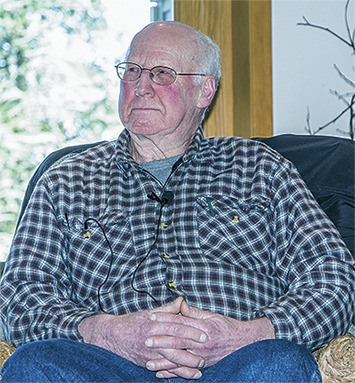Orcas Island has changed a lot since 1889 with new residents, paved streets and much bigger ferries coming into the landing. On one plot of land out in Olga there is a singular relic of the past that stands steadfast and useful as the seasons change. As people pass on and babies are born, it remains constant – it is a rain gauge.
With this simple instrument one Orcas family has kept track of precipitation on their property for 125 years making them the only family in the United States that has a continuous, unbroken record of weather from the exact same spot for more than a century. While other locations’ rain gauges were disturbed by concrete or other aspects of modernization, the Willis family’s’ gauge has never moved one inch.
“It’s important because it allows us to look back on records and see if the climate has changed,” said Marilyn Myers who has been working with John Willis over the past ten years on weather-related projects. “There has only been an average of 1 degree of temperature change in the last 125 years.”
At the recent Garden Club meeting on Feb. 19, the Willis family was honored for their tireless service. The county council offered Willis a proclamation of appreciation of service to the San Juans and beyond.

“The Willis family has been serving our community, state and nation for over 125 years providing daily accurate weather readings,” Councilman Rick Hughes told the Sounder. “This work is important for a better understanding of our environment. In addition, no family has taken on this responsibility longer than the Willis family in the entire country.”
At the meeting Marilyn read a letter from Representative Kristine Lytton to the Willis family praising their work that “has been critical to understanding our state’s history.”
Cliff Mass, professor of atmospheric sciences at the University of Washington, also sent a letter commending the scientific feat. Mass is also known for his popular weather blog.
“Today when concerns about global change have increased, there is nothing more important than reliable long-term climate records,” he wrote. “Of particular importance are climate records in rural areas without significant development because local heating effects from urbanization and land-use change are avoided.”
Willis started taking on the weather recording responsibility by himself in 1985, which means he has been recording for the last 29 years at the same kiosk that his ancestors used in 1889. On the few days he was off-island his four sisters would take on the duty. John is the second eldest child out of five siblings.
He also kept track of the wind in a unique fashion by looking at how high the waves were rising and if any water was coming off the crests of the waves.
“He is so aware of what the water looks like he can gauge the wind,” said Marilyn. “He is so attuned to everything.”
Marilyn said although John turned 75 in October he has no intention of quitting, but hopes in the future someone from the family will take on the responsibility.
Until then, John will continue to preserve his family’s legacy in his quiet and unassuming way.
After receiving his numerous compliments and letters of praise at the Garden Club meeting, John had only a few words to share with the crowded room.
“We didn’t realize that it was that important,” he said with a little smile.
Micro-climates unveiled
For the last year, a group of islanders have been keeping track of high and low temperatures and precipitation on Orcas, San Juan and Lopez. Locations include Buck Mountain, Guthrie Cove, View Haven, North Shore, Enchanted Forest Road, Mt. Constitution, below Mt. Constitution off the Olga highway, Killebrew Lake, Dolphin Bay and Obstruction Pass.
The results of a year-long effort showed that Mt. Constitution received the most rain at 52.89 inches. The south end of Lopez had the least amount of rain of all the sites at 18.63 inches. Roche Harbor also had low amounts of rain at 19.88 inches. The west part of Eastsound had only 22.32 inches. Deer Harbor and Spring Point each had about 25 inches of rainfall. The highlands – 27.75 and Olga – 28.37.
During the storm that started last Sunday, islanders reported diverse snow levels.
In Olga, John Willis reported an inch and a half of snow. Islanders at Point Lawrence, just four miles from the Willis property, had 17 inches.
There was also 17 inches of snow on the side of Buck Mountain. Residents on Mt.Wollard reported 10 to 12 inches. At the end of Obstruction Point there was less then 1 inch. Enchanted Forest Road experienced 8 to 10 inches. The North shore had 5 to 6 inches. Killebrew Lake – 6 inches. The Ferry Landing – 0 inches.
“It does make a difference where we are,” said Marilyn Myers, who has helped to organize this weather-keeping effort.
Marilyn’s husband and fellow “weather geek” attributes different weather patterns on the island to the Olympic rainshadow.
The rainshadow works when rain from the southwest causing it to fall on the other side of the Olympic Mountains. Typically the rainshadow helps islanders stay drier because the Olympic Mountains act as a wall that protects the northeastern Olympic Peninsula and San Juan Islands from the bulk of the rain that moves into the Pacific Northwest.
Other factors include the role of Mt. Constitution, which acts as a sort of buffer and the fact that the island is basically cut in half with two distinct sides. Lots of different elevations including warm valleys and colder, rainier peaks also give the island diverse weather patterns.
For more info, see www.orcasislandgardenclub.org.



